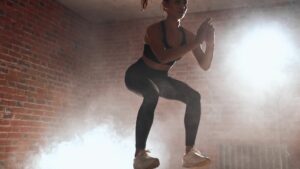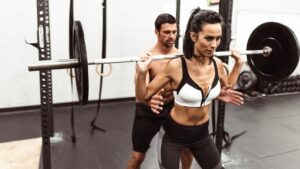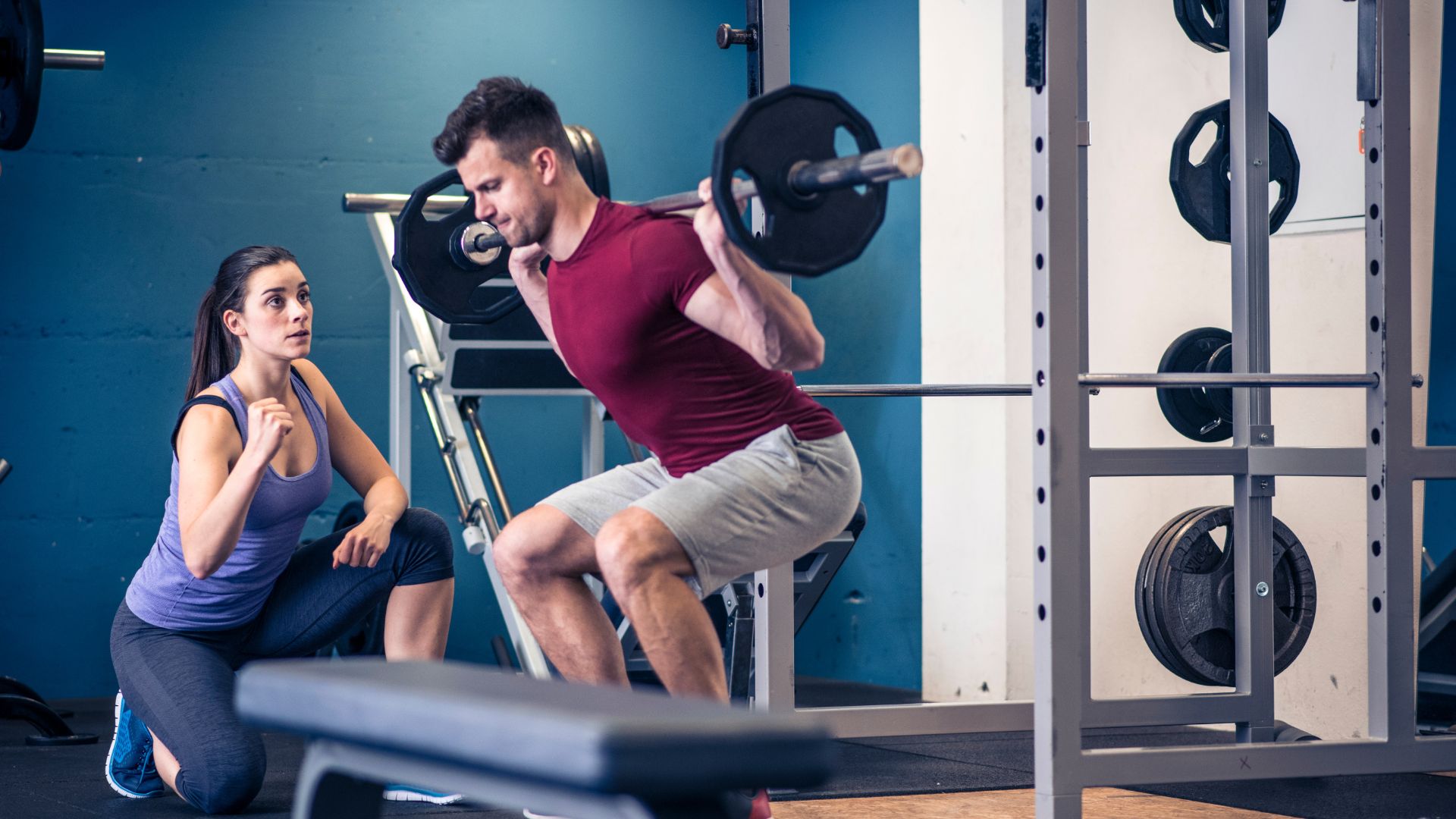Hey there fitness enthusiasts! If you’ve ever wondered when the best time to squat during your workout is, you’re in the right place.
Squats are a powerhouse exercise, but timing matters. In this blog post, we’ll break down the different times to incorporate squats into your routine, whether you’re aiming for strength, hypertrophy, endurance, or just overall fitness.
Let’s dive in and discover the perfect squat strategy for your goals!”
Understanding the best time to squat during a workout: Why and what to consider.
The timing of when to incorporate squats into your workout is not a one-size-fits-all approach. It varies depending on several factors, including your fitness goals, your established workout routine, and your personal preferences.
Let’s break down why these factors matter:
Fitness Goals:
Your fitness objectives play a significant role in determining when to squat. For example:
If your primary goal is to build lower body strength, starting your workout with squats when you’re fresh may allow you to lift heavier weights, making them an excellent choice at the beginning of your routine.
If you’re aiming for muscle hypertrophy (muscle growth), you might include squats after other compound lifts to pre-fatigue your muscles, leading to enhanced muscle recruitment and growth.
If you’re training for a sport like powerlifting or weightlifting, squats may be the main focus, and you might allocate more time and energy to them at the outset of your session.
Workout Routine:
Your established workout routine and the exercises you perform before and after squats also impact the timing.
Squats can be strategically placed within your routine to complement other exercises or achieve specific training outcomes.
Personal Preferences:
Your individual preferences and body’s response to exercise matter. Some individuals may feel more comfortable doing squats early in their workout, while others might prefer them later.
Personal factors such as energy levels and workout enjoyment can influence when you choose to squat.

In essence, there is no universally “best” time to squat during a workout. The key is to align the timing of squats with your unique fitness goals and tailor your workout routine to meet those objectives effectively.
Whether you’re looking to build strength, promote muscle growth, improve functional fitness, or enhance endurance, the timing of your squats should align with your overarching fitness strategy and what works best for you.
In any case here are some considerations for when to include squats in your workout:
Warm-Up: It’s generally a good idea to start your workout with a warm-up to increase blood flow, raise your core body temperature, and prepare your muscles and joints for more intense exercises.
You can include bodyweight squats in your warm-up routine to activate your leg muscles and improve mobility.
Strength Training: If your primary goal is to build strength and muscle in your lower body, squats should be a core exercise in your routine.
Many people prefer to perform compound exercises like squats early in their strength training session when they are fresh and can lift heavier weights. You can start your workout with squats or place them after other compound exercises like deadlifts or bench presses.
Powerlifting or Weightlifting: If you’re specifically training for powerlifting or weightlifting, squats may be the main focus of your workout. In this case, you might allocate more time and energy to squats and place them near the beginning of your workout.
Hypertrophy (Muscle Growth): If you’re targeting muscle hypertrophy, you can include squats after your compound lifts. This allows you to pre-fatigue your muscles with other exercises before focusing on squats to maximize muscle recruitment.
Functional Training: For those looking to improve functional strength and overall fitness, you can incorporate squats at various points during your workout. They can be used as part of a circuit or integrated into full-body workouts.
Endurance or Cardio Workouts: Squats can also be included in endurance or cardio workouts, especially if you’re doing high-intensity interval training (HIIT). Squat jumps or air squats can be used to elevate your heart rate and work on muscular endurance.
Cool Down: If you’ve performed heavy squats earlier in your workout, you can also include light bodyweight squats during your cool-down to promote mobility and help with recovery.
Remember to maintain proper form and use appropriate weights for your fitness level to prevent injury.
Additionally, individual preferences and goals can vary, so it’s essential to tailor your workout routine to meet your specific needs and consult with a fitness professional if you’re unsure about the best placement of squats in your workout.
Further Explanations.
Let’s delve deeper, let me explain these points mentioned further.
First let’s delve deeper into these two key aspects of incorporating squats into your workout: warm-up and strength training.
Warm-Up.
Starting your workout with a warm-up is essential for several reasons:
Increased Blood Flow:
A warm-up gradually increases your heart rate and blood flow to your muscles, which helps deliver oxygen and nutrients while removing waste products.

Core Body Temperature:
It raises your core body temperature, making your muscles more pliable and less prone to injury. This increased temperature can also improve muscle contraction and reaction times.
Joint Lubrication:
A proper warm-up also lubricates your joints, reducing the risk of joint injuries and increasing their range of motion.
Neuromuscular Activation:
Warm-ups activate your nervous system, preparing it for the demands of your workout. This can improve coordination and muscle firing patterns.
Incorporating bodyweight squats into your warm-up routine is an excellent choice, particularly if you plan to do squats during your strength training session. Here’s how you might structure your warm-up:
Start with 5-10 minutes of light cardiovascular exercise like jogging, jumping jacks, or stationary cycling to increase your heart rate.
Follow that with dynamic stretches and mobility exercises to target the muscles you’ll be using in your workout. For squats, focus on hip, knee, and ankle mobility.
Include 2-3 sets of 10-15 bodyweight squats. These squats should be performed with controlled, deliberate movements to activate your leg muscles and reinforce proper squat mechanics.
By incorporating bodyweight squats into your warm-up, you are not only preparing your body for the upcoming squat session but also establishing correct squatting patterns early in your workout.
Strength Training.
When it comes to strength training and squats, the timing of squats in your workout can impact your performance and safety:
Early in the Workout:
Starting your workout with squats when you are fresh allows you to lift heavier weights and maintain better form. This can be advantageous if your primary goal is to build lower body strength.
After Other Compound Exercises:
If you incorporate squats after other compound exercises like deadlifts or bench presses, you’ll be working with pre-fatigued muscles.
This can be beneficial for muscle growth as it places additional stress on your muscles, promoting hypertrophy.
Proper Form:
Regardless of when you include squats in your strength training routine, always prioritize proper form.
This means maintaining a neutral spine, pushing through your heels, and keeping your knees in line with your feet.
Progressive Overload:
Gradually increase the weight you lift over time to continually challenge your muscles and promote strength gains.
Ultimately, the choice of when to include squats in your workout depends on your specific goals and preferences.
Starting with squats when you’re fresh is often recommended for building maximal strength, but incorporating them strategically at different points in your routine can also yield benefits for muscle growth and overall fitness.
let’s explore the specific considerations for incorporating squats into your workout routine when training for powerlifting, weightlifting, or hypertrophy (muscle growth).
Powerlifting or Weightlifting.
When your primary focus is powerlifting or weightlifting, squats play a crucial role in building the necessary strength and technique for these sports. Here’s why you might prioritize squats early in your workout:
Technical Skill Development:
In weightlifting, squats are integral to the clean and jerk and snatch, and in powerlifting, they are one of the three competitive lifts.

Starting your workout with squats allows you to allocate dedicated time and energy to refine your squat technique, which is essential for lifting maximal loads.
Neuromuscular Adaptation:
Lifting heavy weights in the squat requires precise coordination between muscles and neural pathways.
Starting your session with squats allows you to capitalize on your fresh state, optimizing your ability to focus on the intricacies of the lift.
Lifting Heavy:
Both powerlifting and weightlifting involve lifting heavy weights. Squats early in your workout when you are at your strongest enable you to lift the heaviest loads, contributing to strength gains over time.
Energy Allocation:
Squats can be physically and mentally demanding, especially when lifting heavy. By performing them early in your workout, you ensure that you have sufficient energy and mental focus to tackle them effectively.
Hypertrophy (Muscle Growth).
When your goal is muscle hypertrophy (muscle growth), you can strategically place squats in your routine to maximize muscle recruitment and stimulate growth:
Compound Lift Pre-Fatigue:
Starting your workout with other compound exercises like bench presses or rows can pre-fatigue the muscles involved, leaving your lower body fresher for squats. This can lead to greater muscle recruitment in the legs during squats.
Enhanced Metabolic Stress:
Pre-fatiguing the muscles with other compound exercises creates metabolic stress in the targeted muscles.
This metabolic stress, combined with squats, can trigger muscle hypertrophy as the muscles are exposed to a greater stimulus.
Variation and Muscle Balance:
Incorporating squats after other compound lifts allows for variety in your workout and helps ensure a balanced development of your entire body.
Accessory Exercises:
After squats, you can include targeted accessory exercises to further isolate and develop specific leg muscles, promoting muscle growth in a well-rounded manner.
In both scenarios, it’s crucial to pay attention to your form and progressively increase the weights you lift to continue challenging your muscles.
Additionally, individual programming and preferences may vary, so it’s advisable to consult with a coach or trainer who can design a workout plan tailored to your specific goals and needs.
let’s explore how squats can be incorporated into functional training and endurance/cardio workouts:
Functional Training.
Functional training focuses on improving strength and fitness for everyday activities and movements. Squats are a valuable exercise in functional training due to their ability to target multiple muscle groups. Here’s how you can use squats in functional training:
Circuit Training:
Incorporate squats into a circuit workout that includes a variety of functional exercises such as push-ups, lunges, planks, and kettlebell swings.
By doing squats as part of a circuit, you work on functional strength, endurance, and overall fitness.
Full-Body Workouts:
Use squats as a foundational exercise in full-body workouts. This approach ensures that your lower body, core, and upper body are all engaged, mirroring the demands of daily activities.
Balance and Mobility:
While performing squats, focus on balance and mobility by using single-leg squats or adding balance challenges like standing on an unstable surface.
This enhances functional fitness by simulating real-life scenarios that require stability.
Variation:
Experiment with different squat variations, such as goblet squats, sumo squats, or Bulgarian split squats, to target various muscle groups and movements commonly encountered in daily life.
Endurance or Cardio Workouts.
Squats can also be integrated into endurance or cardio workouts to elevate your heart rate and improve muscular endurance. Here’s how you can use squats in these types of workouts:
High-Intensity Interval Training (HIIT):
Incorporate squat jumps into HIIT routines. Perform a set of squat jumps for a specific duration (e.g., 30 seconds) followed by a short rest or low-intensity exercise (e.g., jogging in place). Repeat this cycle to improve cardiovascular fitness and lower body endurance.
Bodyweight Squat Variations:
Air squats (bodyweight squats) can be added to bodyweight-only cardio workouts. Combine them with exercises like burpees, jumping jacks, or mountain climbers for a challenging and effective cardio workout.
Tabata Workouts:
Tabata training involves short bursts of intense exercise followed by brief rest periods. Squats can be included as one of the exercises in a Tabata workout to enhance both aerobic and anaerobic fitness.
Stair Climbing Squats:
Find a set of stairs and incorporate squats into your stair-climbing routine. For example, perform squats at the bottom of the stairs and then sprint up the stairs before returning for another set of squats.
In endurance and cardio workouts, the goal is to elevate your heart rate, increase calorie burn, and improve muscular endurance.
Squats, when used strategically alongside other cardio exercises, can contribute to achieving these goals while also building lower body strength and functional fitness.
As always, ensure proper form during squats to prevent injury, and adjust the intensity and volume of squats based on your fitness level and goals.
Cool Down period.
Incorporating light bodyweight squats into your cool-down can be a beneficial addition to your workout routine, especially if you’ve performed heavy squats or intense lower body exercises earlier in your session.
Here’s how and why you should include them:
Cool-Down Benefits:
Reduced Muscle Tension:
After a challenging workout, your muscles may be tense and fatigued. A cool-down period helps reduce muscle tension by promoting relaxation.
Improved Recovery:
Light exercise during the cool-down phase helps flush out metabolic waste products (such as lactic acid) from your muscles, which can contribute to faster recovery.
Promotion of Flexibility and Mobility:
Cool-down exercises, including bodyweight squats, can enhance joint mobility and flexibility. This is particularly important after heavy squats, as it helps prevent stiffness and potential injury.
How to Incorporate Light Bodyweight Squats into Your Cool-Down:
Duration:
Aim for a brief cool-down period lasting about 5-10 minutes. This should be less intense than your main workout.
Controlled Squats:
Perform bodyweight squats slowly and with controlled movements. Focus on proper form and technique rather than speed or intensity.
Range of Motion:
Pay attention to your range of motion. Descend into the squat as comfortably as possible, ensuring you don’t push too far if you feel any discomfort.
Breathing:
Coordinate your breathing with your movements. Inhale as you descend into the squat, and exhale as you rise back up.
Repetitions:
Perform a set of 10-15 bodyweight squats, or adjust the number based on your fitness level and comfort.
Other Mobility Exercises:
Combine bodyweight squats with other mobility exercises such as hip flexor stretches, hamstring stretches, and calf stretches to target various muscle groups.
Focus on Relaxation:
During the cool-down, concentrate on relaxation and mindfulness. Use this time to reflect on your workout and how your body feels.
By incorporating light bodyweight squats into your cool-down routine, you can help your body transition from the high-intensity workout phase to a state of relaxation and recovery. This practice contributes to better mobility, reduces the risk of post-workout muscle soreness, and sets the stage for future successful workouts.
A tabular on this topic here including benefits.
Here’s a tabular breakdown of the best times to squat during a workout, along with the associated benefits for each timing:
| Timing | Benefits |
|---|---|
| Warm-Up | – Increases blood flow and core body temperature.
– Prepares muscles and joints for exercise. – Activates leg muscles and improves mobility. |
| Strength Training (Early) | – Allows for lifting heavier weights when you are fresh.
– Optimizes form and technique. – Builds maximal lower body strength. |
| Strength Training (Later) | – Promotes muscle growth due to pre-fatigued muscles.
– Enhances overall muscle recruitment. – Diversifies workout routines. |
| Powerlifting or Weightlifting | – Prioritizes squats as a core exercise.
– Focuses on refining squat technique. – Lifting maximal loads for strength development. |
| Hypertrophy (Muscle Growth) | – Introduces squats after compound lifts for muscle hypertrophy.
– Creates metabolic stress for muscle growth. – Provides variation in workouts. |
| Functional Training | – Integrates squats into circuit or full-body workouts.
– Improves functional strength for daily activities. – Enhances balance and mobility. |
| Endurance or Cardio Workouts | – Incorporates squat jumps or air squats to elevate heart rate.
– Builds lower body endurance alongside cardio training. – Ideal for HIIT workouts. |
| Cool Down | – Promotes mobility and flexibility.
– Reduces muscle tension and promotes relaxation. – Aids in recovery after intense squats. |
The best time to squat during a workout depends on your specific goals and workout routine. Each timing has its unique benefits, and you can choose the one that aligns with your fitness objectives and preferences.
Conclusion.
In conclusion, the best time to squat during a workout varies based on your fitness goals, existing workout routine, and personal preferences.
For those seeking maximal strength gains, starting with squats early in the session is effective. If muscle hypertrophy is the aim, placing squats after compound exercises can promote growth.
Meanwhile, functional training, endurance workouts, and cool-downs offer other opportunities to incorporate squats.
Ultimately, the ideal timing depends on your objectives, so customize your squat placement to align with your fitness goals and comfort.

Hey there, it’s Mike Rrsq, the Editor-in-Chief over at Jsquat.com, and I’m absolutely obsessed with all things squat fitness! I’ve been lucky enough to get some serious recognition for my work in this field. With a solid background in the fitness and wellness industry, I’ve been there right from the get-go, helping shape this website into what it is today.
You see, I’m not just the boss around here; I’m also a passionate contributor. I love sharing my insights through my articles, and trust me, they’re not your run-of-the-mill stuff. Each piece I write is a labor of love, filled with my expertise and real-world experience in the fitness universe. So, if you’re into fitness and looking for some inspiration, you’re in the right place!

